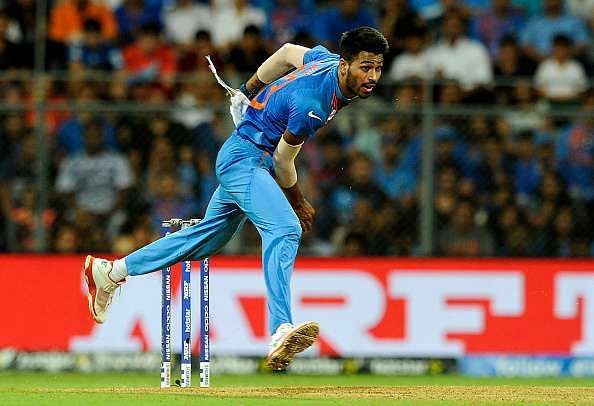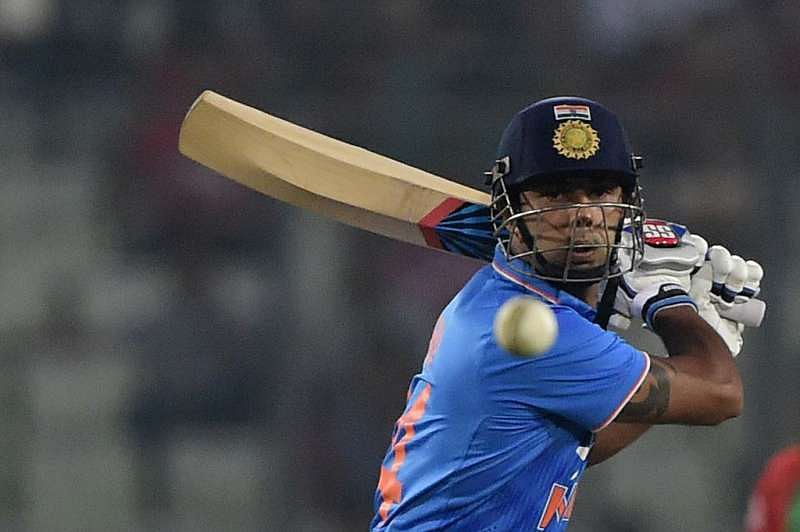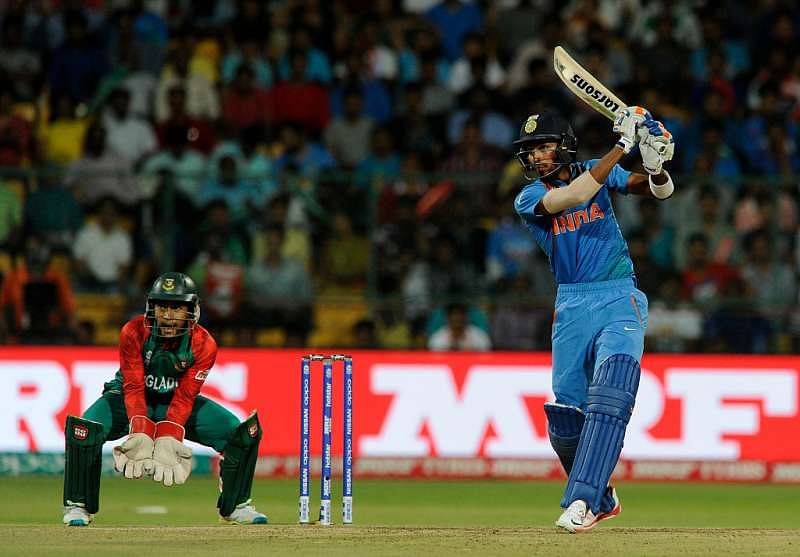
Hardik Pandya: A finisher and an all-rounder - One solution to two problems

At the Feroz Shah Kotla on Thursday, New Zealand had India on the mat for the first time on the tour. After batting first and mustering just 242 runs – an unchallenging target considering Kotla’s short boundaries – they had managed to choke the scoring during India’s run chase.
The openers started cautiously but lost their wickets, Kohli had an off day with the bat and India’s designated finisher and captain himself, Dhoni, managed only 39 runs from 64 balls. Yet, the chase was still well and truly on course until Dhoni’s painstaking innings was cut short by a brilliant one-handed return catch by Tim Southee.
Also read: Hardik Pandya talks about his dream debut
His approach was questionable. He would have hoped to play the waiting game, keep wickets in hand, take the game safely to its conclusion and end it with a flourish, but instead ended up leaving the team in dire straits, requiring them to score more than a run-a-ball with not many wickets in hand.
The writing was on the wall - ‘India needed someone else to try and finish the match’.
Dhoni is a spent force

This was no unfamiliar scenario in recent circumstances. In the last couple of years, Dhoni has failed more often than he has succeeded with his trademark style of taking it deep and finishing the game in the end, as was his wont in his earlier days.
Chris Woakes, Kagiso Rabada, Neville Madziva and Dwayne Bravo, have all denied Dhoni his last over glory shots in various instances. On a few other occasions, both in internationals and in IPL, he has struggled to pace his innings properly.
While he could still play a blinder on the odd day, à la the knock in this year’s IPL against the Kings XI Punjab, these were clear signs that bowlers have found ways to keep him quiet and that the methods which reaped great success for him once, wouldn’t at the same levels of consistency anymore.
His persistence with his methods in the changed scenario seems to make it more difficult for himself and his waning powers and advancing age led to the realization that, now, someone else needed to take over the baton for the future. Thus began the search for the new ‘finisher.’
Pandya’s blinder
Cut back to the present. As Dhoni walked back, in came a young lad with a swagger – Hardik Pandya. Off his 3rd ball, he played a glorious drive through the covers which underlined his confidence. Together with Umesh Yadav, the duo stitched a run-a-ball partnership of close to 50 that kept India within a sniff of victory till the very end.
Before the penultimate over, the equation stood at 16 required off 12 balls and Pandya flat batted one to the mid-off fence. A ball later, he perished to a similar stroke done in by awkward bounce. Pandya’s innings came to an abrupt end and India eventually lost, but not before we were treated to glimpses of a promising future, in just his 2nd ODI.
Besides his cool composure under pressure and his power hitting, what stood out was how he built his own innings as well as getting Yadav to rally around him with some clever running between the wickets. It was no brash hitting, there was a method to it.
Earlier in the week, Dhoni handed the new ball to the debutant, in the series opener at Dharamsala. The youngster responded with 3 early wickets - one of them, an absolute snorter clocked at 141kph, which accounted for the dangerous Martin Guptill.
Though the team and Pandya faced mixed results, in the course of these two matches, India had found a probable solution to one lament of theirs, probably even two – that of a finisher and a seam bowling all-rounder.
Hardik Pandya – A talent of several possibilities

India’s search for a hard-hitting seam bowling all-rounder first started with a near-30-year-old Stuart Binny – a move that raised eyebrows because it was not in Indian tradition to turn to older players at the first instance, but more so because of his father Roger Binny’s presence in the Selection Committee.
The Karnataka all-rounder was an explosive player during his younger days in the breakaway ICL and has a good domestic record, but he is a late starter in the international arena. He started impressively for India with bowling figures of 6/4 in Bangladesh in just his 3rd ODI – the best ever by an Indian in ODIs, breaking Anil Kumble’s long-standing record.
On pitches conducive to swing bowling, he can be a useful asset to the team as a bowling all-rounder who offers a batting option lower down the order, with his ability to swing the new ball with good control and tonk a few with the bat at the end of an innings.
Also read: MS Dhoni backs Hardik Pandya's new-ball skills for 2017 Champions Trophy
For a lower order batsman, he also has a decent batting technique to survive in adversity, as he showed on a few occasions, notably during his match-saving 78 in the Trent Bridge Test and during an innings of 44 against England in the Brisbane ODI.
However, while he is a very wholehearted cricketer within his limitations and has only received a handful of opportunities, his overall performance has been moderate and not overwhelming in fulfilling India’s pressing need to fill that slot.
In his limited appearances, except on the above few occasions, his batting has failed to show promise or deliver the results expected of him. And where the pitch offers no movement and once the new ball loses its shine, he can be a liability with his military medium pace bowling. Most importantly, age is not on his side and he is not getting any younger.
Capable with both bat and ball

It’s here that Pandya steps into the role with plenty of possibilities. He is raw and exuberant, but he is an asset worth the investment in the longer run if he clicks. He is a hard-hitting batsman and an excellent fielder. Above all, he can bowl at sheer pace.
Now, when was the last time India had an all-rounder who could consistently bowl above the 140kph mark? Here’s one.
He can move the ball as well but the extra pace gives him an edge, to succeed even in conditions which do not suit swing bowling and to bowl at any stage of the match. Now, he seems to be bowling with more discipline too. When he first made his appearances through T20Is, he had a tendency to bowl a shortish length, spray the ball around and leak runs.
But so far in his second coming, he seems to be bowling a much better line and length and with more control. The short ball has been used sparingly now and he bowls a fuller length, giving the ball every opportunity to move in the air and off the pitch.
Pandya gives the team several options. With the Champions Trophy round the corner and the ODI World Cup 2019 in focus, both to be played in England, he gives India an excellent choice for a third seamer, in swinging conditions where India will also look to shore up its batting depth through his lower order batting.
Also read: Coach Paras Mhambrey says Hardik Pandya worked really hard to get into the Indian team
There may be lingering doubts about his batting potential in overseas conditions. But, just recently on his A tour to Australia, he had cracked a counter-attacking 79 in a 4-day match when his team folded for a mere 169. Pandya produced that innings on a challenging wicket, with his team struggling and against a bowling attack that had in its ranks the likes of Jackson Bird, Kane Richardson, and Jon Holland, who have represented the Aussie senior side.
It is a well-known fact that Jasprit Bumrah is a more potent bowler with the older ball in the death overs than with the new ball early in the innings when he has often shown the tendency to leak runs. At the death, with his yorkers and deceptive slower ones bowled with an awkward action, batsmen aiming for the big shots find him very difficult to get away. If Pandya can take the new ball and bowl a few overs upfront, it affords India the opportunity to save and utilise a majority of Bumrah’s bowling for where he is most effective.
He received his ODI cap from Kapil Dev, one of the all-time greatest all-rounders of the game. At just over 23 years, young Hardik Pandya’s best years are only ahead of him. If India can back him and allow him to express himself; in Coach Kumble’s words ‘to allow him to go out there and play with freedom, without the burden of specific plans’, this could be an investment which will serve Indian cricket well with good returns in the many years to come.